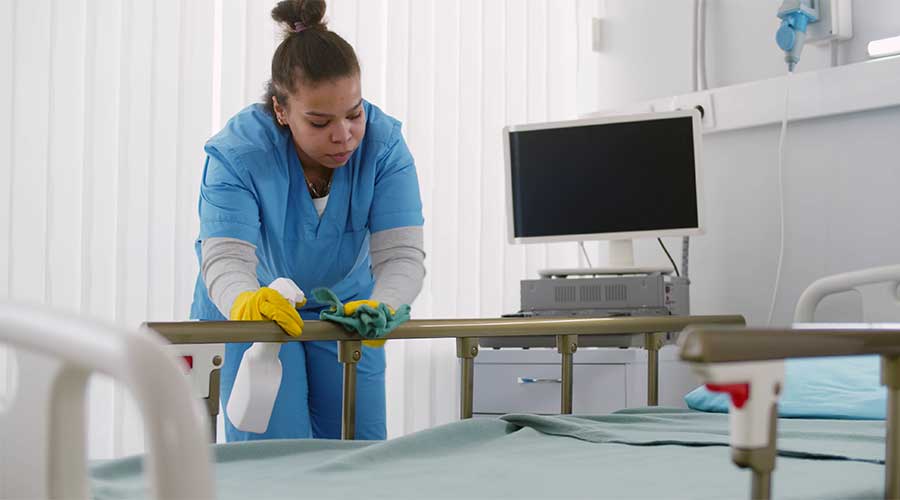Hospital environmental services (EVS) departments do everything possible to create a safe, clean and disinfected patient care environment. Creating and maintaining that environment requires the right products, the right processes and an educated, trained, well-equipped environmental services technician with the right amount of time to do the tasks necessary.
To be truthful, the best efforts to prevent healthcare-associated infections are lost on patients and their companions. Their fear of the possibility of an infection might very well prevent them from seeking medical attention. While hospitalized, they observe the cleanliness of their room surroundings and the hand hygiene or lack thereof of their caregivers.
To that point, a friend of mine was told in a conference with the surgeon who had just performed a joint replacement surgery on his mother, “Get her out of here as soon as possible if you want to keep her from getting an infection.”
Patient fears aren’t unfounded. Research has proven there are many sources of contamination in a patient’s room. We must start with us, human beings. We are always covered in bacteria, some of which can lead to infection if the skin barrier is broken as a result of wounds, sores, burns, cuts and abrasions. So it is critical that patients, companions and healthcare professionals perform proper hand hygiene.
Several studies have investigated the amount of methicillin-resistant Staphylococcus aureus (MRSA) found on surfaces in a typical patient’s room. Of note, the most contaminated objects were bed linens (41 percent), patient gowns (40.5 percent), overbed tables (40 percent), bed rails (34.5 percent) and furniture (27 percent).
Many EVS technicians are reluctant to disinfect overbed tabletops and bed rails because of wetting the patient’s personal space and the fact the disinfectant needs to achieve the EPA-approved label’s dwell time.
For that reason, I propose we add the following wording to the EVS room attendant’s acknowledge, inform, duration, explain and thank you (AIDET) script: “Please allow me to disinfect your tabletop and bed rails to keep you safe from infection. The surface must remain wet until it dries. When it is dry, I will rinse it off with clear water.”
This communicates to the patient and their companions in the room that the hospital is concerned about their health and safety by breaking the chain of infection while not exposing them to the effects of the hospital-approved chemical disinfectant. This could improve Hospital Consumer Assessment of Healthcare Providers and Systems (HCAHPS) scores, as well.
Now that we’ve looked at the most contaminated objects in the patient space, let’s look at the most-touched surfaces. Over 18 months, observers noted each object in the room excluding the restroom touched by healthcare workers during routine patient care. In rooms that were not in the intensive care unit, the high-touch objects with three-plus contacts were bed rails and overbed tables. These were also the most contaminated surfaces.
The deadly combination of high touch and high contamination of environmental surfaces is the perfect storm that can lead to infections in the vulnerable patient population. The education of EVS workers and healthcare professionals is necessary to break the chain of infections while allaying the fears of the patient and their companions.
J. Darrel Hicks, BA, MESRE, CHESP, Certificate of Mastery in Infection Prevention is the Past President of the Healthcare Surfaces Institute. Hicks is nationally recognized as a subject matter expert in infection prevention and control as it relates to cleaning. He is the owner/principal of Safe, Clean and Disinfected. His enterprise specializes in B2B consulting, webinar presentations, seminars and facility consulting services related to cleaning and disinfection. Learn more at www.darrelhicks.com.

 Design Plays a Role in the Future of Healthcare
Design Plays a Role in the Future of Healthcare Cedar Hill Regional Medical Center GW Health Officially Opens
Cedar Hill Regional Medical Center GW Health Officially Opens Designing Healthcare Facilities for Pediatric and Geriatric Populations
Designing Healthcare Facilities for Pediatric and Geriatric Populations Kaiser Permanente Announces New Hospital Tower at Sunnyside Medical Center
Kaiser Permanente Announces New Hospital Tower at Sunnyside Medical Center Building Disaster Resilience Through Collaboration
Building Disaster Resilience Through Collaboration